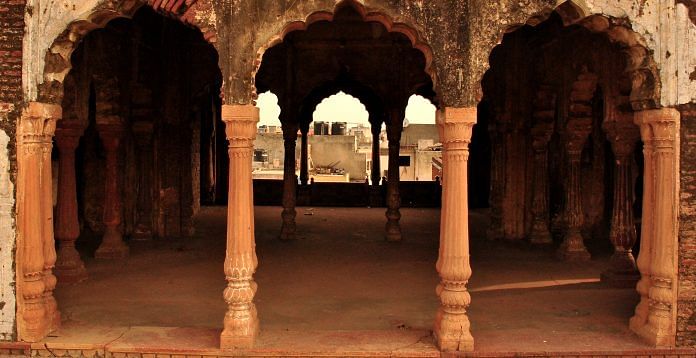Zafar Mahal in Mehrauli, an architectural wonder declared a protected monument, has been subsumed by reckless urban expansion.
New Delhi: Once the summer palace of Bahadur Shah Zafar, the last Mughal emperor, Zafar Mahal in Delhi’s Mehrauli is now a shadow of its past grandeur, reduced to a den of drug addicts, alcoholics and gamblers by years of neglect.
A rusted blue-coloured board fixed at the entrance by the Archaeological Survey of India (ASI) that declares Zafar Mahal a monument of national importance drives home the irony for all visitors.
Built by his father Akbar II in the 18th century, it was first known as Lal Mahal. Bahadur Shah got it renovated and renamed Zafar Mahal. Today, it stands adjacent to the dargah of Qutubuddin Bakhtiar Kaki in one of Mehrauli’s serpentine congested lanes.
At first, Zafar Mahal only had one floor with a few rooms, the Moti Masjid (a private family mosque) and an open area. Bahadur Shah subsequently added a second floor, and constructed the huge Hathi gate as well as a dome-shaped pavilion or chhatri at the centre of the monument.
While the rooms now provide shelter to stray cats and dogs, the open area serves as a makeshift cricket field for local children. Under the chhatri, adults gather for leisure time spent smoking the hookah. Shards of broken beer bottles, old playing cards and cigarette butts litter the entrance from the Hathi gate.
Also read: ASI spent more on its swanky new office than it did on 3,686 monuments in 2017
The 18th-century palace has been all but subsumed by unauthorised constructions. Tall apartment complexes stand at kissing distance, eclipsing its novel Mughal-era architecture with their insipid modern conformity.
Dayanand Paswan, 39, has been working as a security guard at Zafar Mahal for two years. He says the unauthorised constructions have been reported to authorities, but to no avail.
He recounted a recent incident, where around 20 men gathered on the premises to drink and gamble. “Suddenly, all of them started to fight with each other. Somebody called police, but they had run away by then,” Paswan added.
Paswan said he never interfered in such brawls. “Police have instructed me to not fight with people. It is not safe here,” he added.
Mehrauli MLA Naresh Yadav, a member of the Aam Aadmi Party (AAP), said officials of the municipal corporation and the Archaeological Survey of India (ASI) colluded with builders and took bribes from them.
“I have visited the ASI office to complain about these encroachments. But nobody took any action,” he told ThePrint.
He said the Centre was equally to blame for the neglect of significant monuments. “If they cannot take care of them, then give us the responsibility. We are ready to maintain and renovate these heritage sites,” Yadav added.
As reported by ThePrint earlier, the ASI has spent Rs 305.3 crore on the construction of its new headquarters since 2016, but shelled out no more than Rs 206.55 crore in 2017-18 on the conservation of the 3,686 centrally protected monuments under its care.
Yadav’s comment started a merry-go-round of blame, with every stakeholder agency laying the blame at someone else’s door.
Talking to ThePrint, ASI spokesperson D.N. Dimri said, “Notices were issued against all the unauthorised buildings around Zafar Mahal. We do not have the power to demolish them. It’s now the responsibility of the district collector.”
However, the office of the Mehrauli sub-divisional magistrate told ThePrint that they had not received any notice “in the recent past”.
When asked about the date and year the notices were issued, Dimri said, “It’s not my responsibility to tell you this. I will not give the date and year.”
The ASI Delhi circle did not respond to ThePrint’s emails requesting comment.
Bahadur Shah Zafar II wished to be buried inside Zafar Mahal, next to the grave of his father in Sardgah, a marble enclosure. But the British arrested him for treason after the revolt of 1857, and he was exiled to the erstwhile Rangoon (now Yangon, Myanmar).
According to a BBC report, he died in a “shabby wooden house” in 1862 and was buried by his British captors in an unmarked grave by a pagoda.
As the emperor himself wrote in a prophetic poem before his death:
“Kitna hai badnaseeb Zafar, dafn ke liye
Do gaz zameen bhi na mili koo-e-yaar mein.
How unfortunate is Zafar, didn’t even find two yards of land for burial in his beloved land.”
Also read: India’s top 5 revenue generating monuments were all built by Muslim rulers




Illegal construction is more dangerous in long term than few during brawls.